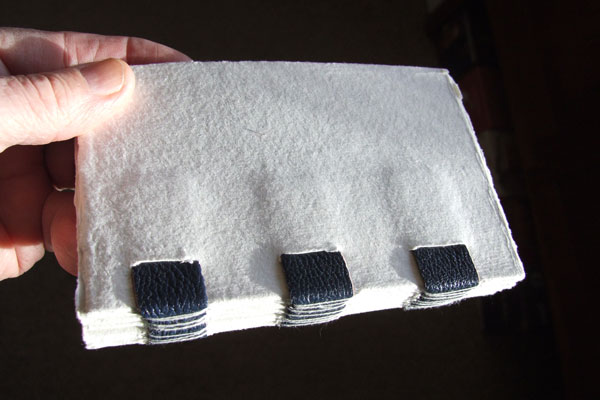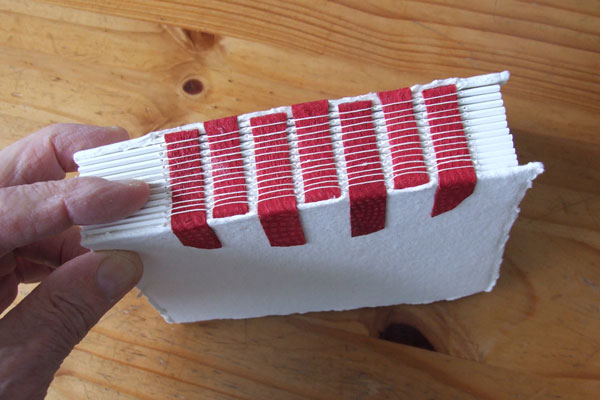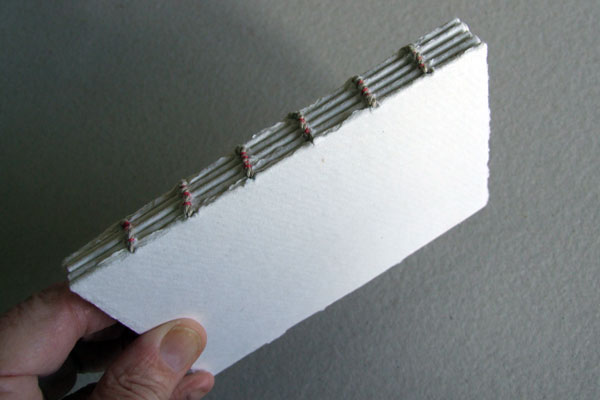
Leather bound ~ Edison [125921]
This is a BusyBusy Discovery Project. The aim is to provide information about books that can easily be made from simple materials in a certain ~ slightly unconventional ~ style. Most of the techniques required can be mastered within a few minutes, and they will all be useful should readers wish to progress to more advanced ~ traditional ~ bookbinding.
The various styles have been given names of various long-deceased inventors and discoverers. There is no relevance to the achievements of these people to that of the books ~ the names are simply labels ~ as are Coptic Binding [115083] and Longstitch Binding [115071] ~ both of which have some relevance to Boole Bindings.

This page has been given a title Boole for ease of our reference. There are related projects which have names of other discoverers. There is no relationship between the people and the projects I describe. I am using simple names as a convenient reference for my own local use.


Project Boole covers a variety of bookcraft techniques which have the one similarity of open backs.
Coptic binding [115027] is one of the earliest styles of binding ~ fragments exist from nearly two thousand years ago. The main features of Coptic binding are ~ the open backs ~ the codex sewing ~ the use of wooden board covers ~ and the use of the sewing thread as the main hinge.
The Boole books have a variety of cover options and a wider range of sewing techiques ~ the common factor is the codex binding [115223]. I am keen to discuss replacement of the threads as the hinges. I consider them a point of weakness with wear.
There are many advantages of a Boole-bound book. They are ~
~ pages are solidly bound
This is the essence of bookbinding. I reckon that this type of binding will outlast many other more 'normal' types. Experience suggest to me that threads wear out more frequentl than pages tear at the fold.
~ spreads open fully flat
This varies greatly with different types of binding. For some uses ~ an artist's sketchbook ~ it is important to have the spread completely flat, and without any need to hold them open. I have often been asked to advise on how to bind cookery books so that they lie flat ~ it does take up space ~ some people have book stands to hold them upright and open [126991].
~ easy to make
I think that this is one of the easiest book-making techniques. If working from an 'easy' kit, then very little sewing skill is required ~and little else. It is possible to pre-make big needle holes and then use plastic needles ~ which are fairly blunt ~ with youngsters.
~ economical to make
The covers ~ especially ~ can be made from a huge variety of materials that would otherwise go to waste. The hinges and pages can also be of any suitable material.
~ any thickness
The number of pages can be small or large. When preparing materials at the start of the project the length of the hinge straps can be chosen accordingly, and (within limits) can be adjusted later.
~ easy to add pages
Plans can be put into place at the design and planning stage to decide the number of pages and then either fix that number, or (with suitable re-design) add more pages as an afterthought.
~ easy to remove pages
A snip with scissors is all that is required to remove a bundle of folios.
~ easy to replace pages
If the hinge length is fixed a gap can be re-filled with ease
~ easy to rearrange folios
This inolves a removing a section of folios, and then re-sewing them in at the new place ~ rearranging the folios within a single section is included in this possibility. The ~1,2,3,4 ~or 1,2,7,8 ~ pagination of a single folio cannot be overcome.
~ width and heights can be any size
Pocket-books can be made as readily as huge scrapbooks.
~ different paper styles
The sections open equally well, and will not behave differently if of mixed media.
~ stubs are easy to fix
Scrapbooks and albums require stubs to space out the sections to allow for insertions. This can involve sewing narrow strips of paper or card. A Boole book has a variety of easier and more flexible methods if increasing spacing betweensections.
~ they can be repaired if they fall to bits
If threads break they are easy to replace. If the leather or cloth strips break they can be probably be replaced ~ depending on the strength of attachment to the covers. They may require new covers ~ and vice versa for covers and strips.
~ trimming is not so esential
For many people a 'proper' book requires smooth edges all round. This style does not have the same perceived requirement to be 'proper'. This is because the sections are more loosely joined together. A half-way measure can be obtained by trimming each section separately ~ which hobby-binders are able to do quite easily.
~ user friendly in all respects
Other book bindings offer some of the above advantages. I have not listed any disadvantages, and would be pleased to include some disadvantages should anyone write and convince me they are reasonable points to moan about [mail].
